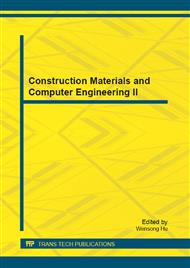[1]
J. Kotowicz, A. Skorek-Osikowska, . Bartela, Economic and environmental evaluation of selected advanced power generation technologies, Proceedings of the Institution of Mechanical Engineers, Part A: Journal of Power and Energy 225 (3) (2011).
DOI: 10.1177/2041296710394280
Google Scholar
[2]
G. De Lorenzo, P. Fragiacomo, A methodology for improving the performance of molten carbonate fuel cell/gas turbine hybrid systems, International Journal of Energy Research 36 (1) (2012) 96–110.
DOI: 10.1002/er.1789
Google Scholar
[3]
G. De Lorenzo, P. Fragiacomo, Electrical and electrical-thermal power plants with molten carbonate fuel cell/gas turbine-integrated systems, International Journal of Energy Research 36 (2) (2012) 153–165.
DOI: 10.1002/er.1788
Google Scholar
[4]
J. Kupecki, K. Badyda, SOFC-based micro-CHP system as an example of efficient power generation unit, Archives of Thermodynamics 32 (3) (2011) 33–43.
DOI: 10.2478/v10173-011-0011-7
Google Scholar
[5]
W. Budzianowski, Low-carbon power generation cycles: the feasibility of CO2 capture and opportunities for integration, Journal of Power Technologies 91 (1) (2011) 6–13.
Google Scholar
[6]
D. Sánchez, B. Monje, R. Chacartegui, S. Campanari, Potential of molten carbonate fuel cells to enhance the performance of chp plants in sewage treatment facilities, International Journal of Hydrogen Energy 38 (1) (2013) 394–405.
DOI: 10.1016/j.ijhydene.2012.09.145
Google Scholar
[7]
D. Bakalis, A. Stamatis, Incorporating available micro gas turbines and fuel cell: Matching considerations and performance evaluation, Applied Energy 103 (2013) 607–617.
DOI: 10.1016/j.apenergy.2012.10.026
Google Scholar
[8]
G. Discepoli, G. Cinti, U. Desideri, D. Penchini, S. Proietti, Carbon capture with molten carbonate fuel cells: Experimental tests and fuel cell performance assessment, International Journal of Greenhouse Gas Control 9 (2012) 372–384.
DOI: 10.1016/j.ijggc.2012.05.002
Google Scholar
[9]
H. Jeong, S. Cho, D. Kim, H. Pyun, D. Ha, C. Han, M. Kang, M. Jeong, S. Lee, A heuristic method of variable selection based on principal component analysis and factor analysis for monitoring in a 300 kw mcfc power plant, International Journal of Hydrogen Energy 37 (15) (2012).
DOI: 10.1016/j.ijhydene.2012.04.135
Google Scholar
[10]
S. Bozorgmehri, M. Hamedi, Modeling and optimization of anode-supported solid oxide fuel cells on cell parameters via artificial neural network and genetic algorithm, Fuel Cells 12 (1) (2012) 11–23.
DOI: 10.1002/fuce.201100140
Google Scholar
[11]
H. Marzooghi, M. Raoofat, M. Dehghani, G. Elahi, Dynamic modeling of solid oxide fuel cell stack based on local linear model tree algorithm, International Journal of Hydrogen Energy 37 (5) (2012) 4367–4376.
DOI: 10.1016/j.ijhydene.2011.11.149
Google Scholar
[12]
J. Arriagada, P. Olausson, A. Selimovic, Artificial neural network simulator for SOFC performance prediction, Journal of Power Sources 112 (1) (2002) 54–60.
DOI: 10.1016/s0378-7753(02)00314-2
Google Scholar
[13]
F. Jurado, Power supply quality improvement with a SOFC plant by neural-network-based control, Journal of Power Sources 117 (1-2) (2003) 75–83.
DOI: 10.1016/s0378-7753(03)00309-4
Google Scholar
[14]
H. Huo, X. Zhu, G. Cao, Nonlinear modeling of a SOFC stack based on a least squares support vector machine, Journal of Power Sources 162 (2) (2006) 1220–1225.
DOI: 10.1016/j.jpowsour.2006.07.031
Google Scholar
[15]
X. Wu, X. Zhu, G. Cao, H. Tu, Nonlinear modelling of a SOFC stack by improved neural networks identification, Zhejiang University Press 8 (2007) 1505–1509.
DOI: 10.1631/jzus.2007.a1505
Google Scholar
[16]
X. Wu, X. Zhu, G. Cao, H. Tu, Modeling a SOFC stack based on ga-rbf neural networks identification, Journal of Power Sources 167 (1) (2007) 145–150.
DOI: 10.1016/j.jpowsour.2007.01.086
Google Scholar
[17]
E. Entchev, L. Yang, Application of adaptive neuro-fuzzy inference system techniques and artificial neural networks to predict solid oxide fuel cell performance in residential microgeneration installation, Journal of Power Sources 170 (1) (2007).
DOI: 10.1016/j.jpowsour.2007.04.015
Google Scholar
[18]
J. Milewski, K. Świrski, Modelling the SOFC behaviours by artificial neural network, International Journal of Hydrogen Energy 34 (13) (2009) 5546–5553.
DOI: 10.1016/j.ijhydene.2009.04.068
Google Scholar
[19]
J. Milewski, K. Świrski, M. Santarelli, P. Leone, Advanced Methods of Solid Oxide Fuel Cell Modeling, 1st Edition, Springer-Verlag London Ltd., (2011).
DOI: 10.1007/978-0-85729-262-9
Google Scholar
[20]
N. Kishor, S. Mohanty, Fuzzy modeling of fuel cell based on mutual information between variables, International Journal of Hydrogen Energy 35 (8) (2010) 3620–3631.
DOI: 10.1016/j.ijhydene.2010.01.049
Google Scholar
[21]
K. Chaichana, Y. Patcharavorachot, B. Chutichai, D. Saebea, S. Assabumrungrat, A. Arpornwichanop, Neural network hybrid model of a direct internal reforming solid oxide fuel cell, International Journal of Hydrogen Energy 37 (3) (2012) 2498–2508.
DOI: 10.1016/j.ijhydene.2011.10.051
Google Scholar
[22]
D. Grondin, J. Deseure, P. Ozil, J. -P. Chabriat, B. Grondin-Perez, A. Brisse, Solid oxide electrolysis cell 3d simulation using artificial neural network for cathodic process description, Chemical Engineering Research and Design 91 (1) (2013).
DOI: 10.1016/j.cherd.2012.06.003
Google Scholar
[23]
H. Demuth, M. Beale, M. Hagan, Neural Network Toolbox 6 User's Guide Matlab.
Google Scholar
[24]
F. Foresee, M. Hagan, Gauss-newton approximation to bayesian regularization, in: Proceedings of the 1997 International Joint Conference on Neural Networks, (1997).
DOI: 10.1109/icnn.1997.614194
Google Scholar
[25]
J. Milewski, K. Swirski, Hybrid – artificial neural network as solid oxide fuel cell model, in: Hydrogen + Fuel Cells, 2009, p. A00179.
Google Scholar
[26]
F. Zhao, A. Virkar, Dependence of polarization in anode-supported solid oxide fuel cells on various cell parameters, Journal of Power Sources 141 (1) (2005) 79 – 95.
DOI: 10.1016/j.jpowsour.2004.08.057
Google Scholar
[27]
Y. Jiang, A. V. Virkar, Fuel composition and diluent effect on gas transport and performance of anode-supported sofcs, Journal of The Electrochemical Society 150 (7) (2003) A942–A951.
DOI: 10.1149/1.1579480
Google Scholar
[28]
A. Virkar, L. Wilson, Low-temperature, anode-supported high power density solid oxide fuel cells with nanostructured electrodes, Tech. rep., Department of Energy, USA (2003).
DOI: 10.2172/812922
Google Scholar


